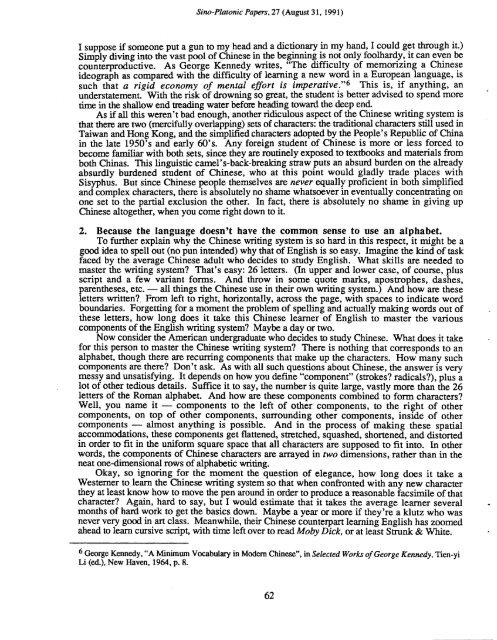Essays on Writing and Language in Honor - Sino-Platonic Papers
Essays on Writing and Language in Honor - Sino-Platonic Papers
Essays on Writing and Language in Honor - Sino-Platonic Papers
You also want an ePaper? Increase the reach of your titles
YUMPU automatically turns print PDFs into web optimized ePapers that Google loves.
S<strong>in</strong>o-PEat<strong>on</strong>ic <strong>Papers</strong>, 27 (August 3 1, 199 1)<br />
I suppose if some<strong>on</strong>e put a gun to my head <strong>and</strong> a dicti<strong>on</strong>ary <strong>in</strong> my h<strong>and</strong>, I could get through it.)<br />
Simply div<strong>in</strong>g <strong>in</strong>to the vast pool of Ch<strong>in</strong>ese <strong>in</strong> the beg<strong>in</strong>n<strong>in</strong>g is not <strong>on</strong>ly foolhardy, it can even be<br />
counterproductive. As George Kennedy writes, "The difficulty of memoriz<strong>in</strong>g a Ch<strong>in</strong>ese<br />
ideograph as compared with the difficulty of learn<strong>in</strong>g a new word <strong>in</strong> a European language, is<br />
such that a rigid ec<strong>on</strong>omy of mental effort is imperative."6 This is, if anyth<strong>in</strong>g, an<br />
understatement. With the risk of drown<strong>in</strong>g so great, the student is better advised to spend more<br />
time <strong>in</strong> the shallow end tread<strong>in</strong>g water before head<strong>in</strong>g toward the deep end.<br />
As if all this weren't bad enough, another ridiculous aspect of the Ch<strong>in</strong>ese writ<strong>in</strong>g system is<br />
that there are two (mercifully overlapp<strong>in</strong>g) sets of characters: the traditi<strong>on</strong>al characters still used <strong>in</strong><br />
Taiwan <strong>and</strong> H<strong>on</strong>g K<strong>on</strong>g, <strong>and</strong> the simplified characters adopted by the People's Republic of Ch<strong>in</strong>a<br />
<strong>in</strong> the late 1950's <strong>and</strong> early 60's. Any foreign student of Ch<strong>in</strong>ese is more or less forced to<br />
become familiar with both sets, s<strong>in</strong>ce they are rout<strong>in</strong>ely exposed to textbooks <strong>and</strong> materials from<br />
both Ch<strong>in</strong>as. This l<strong>in</strong>guistic camel's-back-break<strong>in</strong>g straw puts an absurd burden <strong>on</strong> the already<br />
absurdly burdened student of Ch<strong>in</strong>ese, who at this po<strong>in</strong>t would gladly trade places with<br />
Sisyphus. But s<strong>in</strong>ce Ch<strong>in</strong>ese people themselves are never equally proficient <strong>in</strong> both simplified<br />
<strong>and</strong> complex characters, there is absolutely no shame whatsoever <strong>in</strong> eventually c<strong>on</strong>centrat<strong>in</strong>g <strong>on</strong><br />
<strong>on</strong>e set to the partial exclusi<strong>on</strong> the other. In fact, there is absolutely no shame <strong>in</strong> giv<strong>in</strong>g up<br />
Ch<strong>in</strong>ese altogether, when you come right down to it.<br />
2. Because the language doesn't have the comm<strong>on</strong> sense to use an alphabet.<br />
To further expla<strong>in</strong>-why the Ch<strong>in</strong>ese writ<strong>in</strong>g system is so hard <strong>in</strong> this respect,-it might be a<br />
good idea to spell out (no pun <strong>in</strong>tended) why that of English is so easy. Imag<strong>in</strong>e the k<strong>in</strong>d of task<br />
faced by the average Ch<strong>in</strong>ese adult who decides to study English. What skills are needed to<br />
master the writ<strong>in</strong>g system? That's easy: 26 letters. (In upper <strong>and</strong> lower case, of course, plus<br />
script <strong>and</strong> a few variant forms. And throw <strong>in</strong> some quote marks, apostrophes, dashes,<br />
parentheses, etc. - all th<strong>in</strong>gs the Ch<strong>in</strong>ese use <strong>in</strong> their own writ<strong>in</strong>g system.) And how are these<br />
letters written? From left to right, horiz<strong>on</strong>tally, across the page, with spaces to <strong>in</strong>dicate word<br />
boundaries. Forgett<strong>in</strong>g for a moment the problem of spell<strong>in</strong>g <strong>and</strong> actually mak<strong>in</strong>g words out of<br />
these letters, how l<strong>on</strong>g does it take this Ch<strong>in</strong>ese learner of English to master the various<br />
comp<strong>on</strong>ents of the Enghsh writ<strong>in</strong>g system? Maybe a day or two.<br />
Now c<strong>on</strong>sider the American undergraduate who decides to study Ch<strong>in</strong>ese. What does it take<br />
for this pers<strong>on</strong> to master the Ch<strong>in</strong>ese writ<strong>in</strong>g system? There is noth<strong>in</strong>g that corresp<strong>on</strong>ds to an<br />
alphabet, though there are recurr<strong>in</strong>g comp<strong>on</strong>ents that make up the characters. How many such<br />
comp<strong>on</strong>ents are there? D<strong>on</strong>'t ask. As with all such questi<strong>on</strong>s about Ch<strong>in</strong>ese, the answer is very<br />
messy <strong>and</strong> unsatisfymg. It depends <strong>on</strong> how you def<strong>in</strong>e "comp<strong>on</strong>ent" (strokes? radicals?), plus a<br />
lot of other tedious details. Suffice it to say, the number is quite large, vastly more than the 26<br />
letters of the Roman alphabet. And how are these comp<strong>on</strong>ents comb<strong>in</strong>ed to form characters?<br />
Well, you name it - comp<strong>on</strong>ents to the left of other comp<strong>on</strong>ents, to the right of other<br />
comp<strong>on</strong>ents, <strong>on</strong> top of other comp<strong>on</strong>ents, surround<strong>in</strong>g other comp<strong>on</strong>ents, <strong>in</strong>side of other<br />
comp<strong>on</strong>ents - almost anyth<strong>in</strong>g is possible. And <strong>in</strong> the process of mak<strong>in</strong>g these spatial<br />
accommodati<strong>on</strong>s, these comp<strong>on</strong>ents get flattened, stretched, squashed, shortened, <strong>and</strong> dis t<strong>on</strong>ed<br />
<strong>in</strong> order to fit <strong>in</strong> the uniform square space that all characters are supposed to fit <strong>in</strong>to. In other<br />
words, the comp<strong>on</strong>ents of Ch<strong>in</strong>ese characters are arrayed <strong>in</strong> zwo dimensi<strong>on</strong>s, rather than <strong>in</strong> the<br />
neat <strong>on</strong>e-dimensi<strong>on</strong>al rows of alphabetic writ<strong>in</strong>g.<br />
Okay, so ignor<strong>in</strong>g for the moment the questi<strong>on</strong> of elegance, how l<strong>on</strong>g does it take a<br />
Westerner to learn the Ch<strong>in</strong>ese writ<strong>in</strong>g system so that when c<strong>on</strong>fk<strong>on</strong>ted with any new character<br />
they at least know how to move the pen around <strong>in</strong> order to produce a reas<strong>on</strong>able facsimile of that<br />
character? Aga<strong>in</strong>, hard to say, but I would estimate that it takes the average learner several<br />
m<strong>on</strong>ths of hard work to get the basics down. Maybe a year or more if they're a klutz who was<br />
never very good <strong>in</strong> art class. Meanwhile, their Ch<strong>in</strong>ese counterpart learn<strong>in</strong>g English has zoomed<br />
ahead to learn cursive script, with time left over to read Moby Dick, or at least Smnk & White.<br />
George Kennedy, "A M<strong>in</strong>imum Vocabulary <strong>in</strong> Modem Ch<strong>in</strong>ese", <strong>in</strong> Selected Works of George Kennedy, Tien-yi<br />
Li (ed.), New Haven, 1964, p. 8.

















